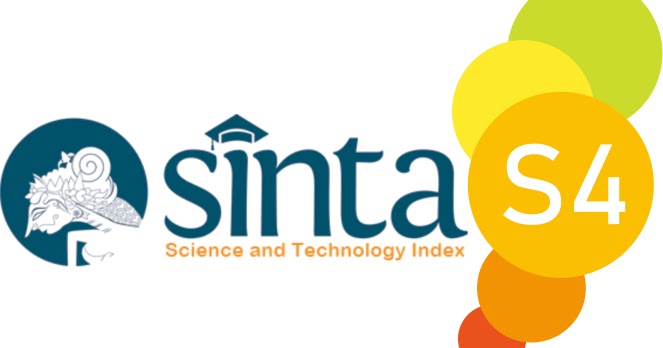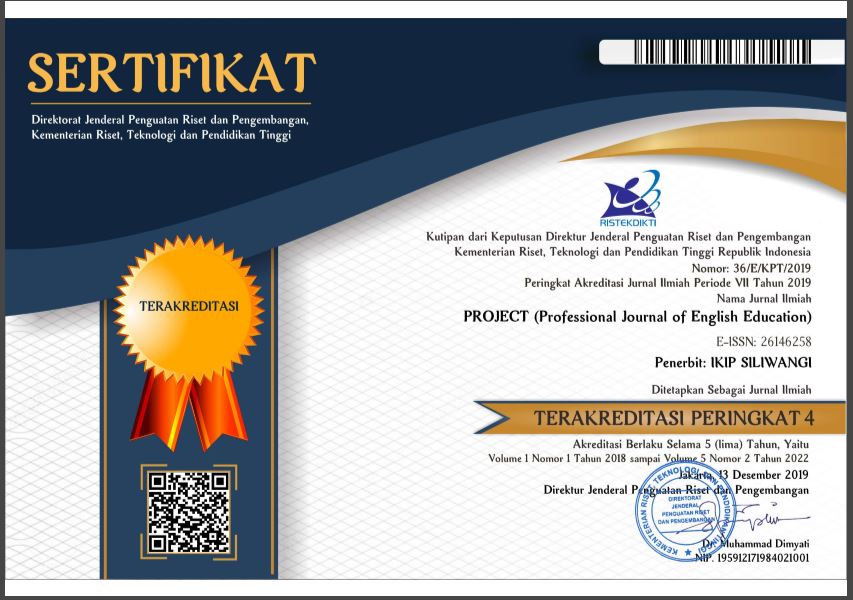Students' Perceptions of Grammarly Application Feedback on Writing Skill at SMAN 4 Palangka Raya
Abstract
Grammarly is an online tool that helps users improve their writing by correcting errors in grammar, vocabulary, and mechanics. With its growing use among students, it is important to understand their perceptions of the tool. This research investigates the perceptions of SMAN 4 Palangka Raya students regarding Grammarly's feedback on their writing skill during the 2024–2025 academic year. Using a descriptive quantitative design, a survey was distributed to 91 students who regularly used Grammarly. The questionnaire gathered data on students' perceptions of Grammarly's feedback features, quality and impact, and overall usage. Analysis was conducted using frequency distributions, percentages, and mean scores in Microsoft Excel. The results show that students have a positive perception of Grammarly, with a mean score of 4.19, highlighting its effectiveness in improving grammar, vocabulary, and mechanics. Students value its ability to identify errors, suggest vocabulary, and correct spelling, punctuation, and capitalization. Grammarly's feedback not only enhances writing quality but also boosts confidence and motivation. The tool's accessibility and user-friendly interface, even in the free version, further reinforce its positive perception. However, individual factors such as prior writing ability, learning preferences, and technical issues influenced how students perceived its effectiveness.
References
Aidil, T. M. (2021). Exploring Students’ Perception On The Effectiveness Of “Grammarly Software” In Academic Writing (Doctoral dissertation, UIN Ar-Raniry).
Armanda, M. L., Nugraheni, A. F., Wulansari, A., & Imron, A. (2022). Grammarly" as English writing assistant from EFL students’ perspective. English Education: Journal of English Teaching and Research, 7(2), 128-137.
Billa, S. (2024). English Students’ Perception toward the Use of Grammarly in Writing an Undergraduate Thesis at Jambi University (Doctoral dissertation, Universitas Jambi).
Bimo Walgito, B. W. (2004). Pengantar Psikologi Umum.
Creswell, J. W., & Creswell, J. D. (2017). Research design: Qualitative, quantitative, and mixed methods approaches. Sage publications.
Dewi, U. (2022). Grammarly as automated writing evaluation: Its effectiveness from EFL students’ perceptions. Lingua Cultura, 16(2), 155-161.
Faisal, F., & Carabella, P. A. (2023). Utilizing Grammarly in an academic writing process: Higher-education students’ perceived views. Journal of English Language Teaching and Linguistics, 8(1), 23-42.
Fitria, R. A., Sabarun, S., & Miftah, M. Z. (2022). Students’ perception of the use of grammarly in undergraduate thesis writing. PROJECT (Professional Journal of English Education), 5(2), 366-371.
Fitriana, K., & Nurazni, L. (2022). Exploring English Department Students' Perceptions on Using Grammarly to Check the Grammar in Their Writing. Journal of English Teaching, 8(1), 15-25.
Fowler Jr, F. J. (2013). Survey research methods. Sage publications.
Ghufron, M. A., & Rosyida, F. (2018). The role of Grammarly in assessing English as a Foreign Language (EFL) writing. Lingua Cultura, 12(4), 395-403.
Godwin-Jones, R. (2022). Partnering with AI: Intelligent writing assistance and instructed language learning.
Hattie, J., & Timperley, H. (2007). The power of feedback. Review of educational research, 77(1), 81-112.
Han, B. (2019). Application of Artificial Intelligence in Autonomous English Learning Among College Students. International Journal of Emerging Technologies in Learning, 14(6).
Hakiki, G. N. R. (2021). Perception of EFL students on the use Grammarly application in writing class. Eduvelop: Journal of English Education and Development, 4(2), 99-106.
Huang, X., Zou, D., Cheng, G., Chen, X., & Xie, H. (2023). Trends, research issues and applications of artificial intelligence in language education. Educational Technology & Society, 26(1), 112-131.
Jansen, H. (2010). The logic of qualitative survey research and its position in the field of social research methods. In Forum Qualitative Sozialforschung/Forum: Qualitative Social Research (Vol. 11, No. 2).
Kafrawi, M. (2022). Meningkatkan Kemampuan Menulis Kreatif Untuk Siswa SMK Labor Pekanbaru. BIDIK: Jurnal Pengabdian kepada Masyarakat, 3(1), 43-46.
Khan, M. O., Nazim, M., & Alzubi, A. A. F. (2024). Exploring Arab EFL Learners' Attitudes: Is Grammarly a Game-Changer in Academic Writing Classes?. Educational Administration: Theory And Practice, 30(4), 1365-3171.
Kluger, A. N., & DeNisi, A. (1996). The effects of feedback interventions on performance: a historical review, a meta-analysis, and a preliminary feedback intervention theory. Psychological bulletin, 119(2), 254.
Le Phan, T. N. (2023, November). Students' perceptions of the AI technology application in English writing classes. In Proceedings of the AsiaCALL International Conference (Vol. 4, pp. 45-62).
Nurhidayah, A., & Irawati, T. (2024). Grammarly Through the Lens of Student Perception. Jurnal Bahasa, Sastra, dan Studi Amerika, 30(1), 11-18. doi:http://dx.doi.org/10.20961/jbssa.v30i1.87858
NURO'AZAH, D. E. W. I. (2019). The Effectiveness of Grammarly Checker Toward Student'a Writing Quality of The Fourth Semester of English Departement at IAIN Tulungagung.
Obilor, E. I. (2019). Feedback and students' learning. International Journal of Innovative Research in Education, 7(2), 40-47.
ONeill, R., & Russell, A. (2019). Stop! Grammar time: University students’ perceptions of the automated feedback program Grammarly. Australasian Journal of Educational Technology, 35(1).
Putri, S., Erni, E., & Masyhur, M. (2024). English Study Program Students’ Perception on Using Grammarly as an Online Grammar Checker in Academic Writing. AURELIA: Jurnal Penelitian dan Pengabdian Masyarakat Indonesia, 3(2), 819-830.
Rakya, Z. H. (2023). Exploring the impact of artificial intelligence (AI) on learner-instructor interaction in online learning (Literature Review). International Journal of Emerging Multidisciplinary: Computer Science & Artificial Intelligence, 2(1), 1-14.
Samosir, S. A., & Daulay, S. H. (2023, July). EFL students’ perception of the use “Grammarly application” as Automated Writing Evaluation (AWE). In Conference on English Language Teaching (pp. 928-940).
Tarsan, V., Kandang, A., & Helmon, A. (2021). Students perception towards the application of grammarly: the automatic grammar checker in writing narrative text in the third semester at stkip ypup makassar. JIPD (Jurnal Inovasi Pendidikan Dasar), 5(2), 123-133.
Thomas, L. E. (2023). Paragraph Structures. AMWA Journal, 38(1).
Ummah, L. K., & Bisriyah, M. (2022). EFL students’ perception on Grammarly premium’s feedback and dealing with inaccuracies. JEES (Journal of English Educators Society), 7(2), 163-172.
Vygotsky, L. S. (1978). Mind in society: The development of higher psychological processes (Vol. 86). Harvard university press.
Yurika, F., & Farahdiba, S. (2023). Students’ Perceptions Toward The Use of Grammarly as A Grammar Checker In The Process Of Writing. In Journal of Technology in Language Pedagogy (JTechLP) (Vol. 2, Issue 2).
Downloads
Published
Issue
Section
License

This work is licensed under a Creative Commons Attribution-ShareAlike 4.0 International License.




